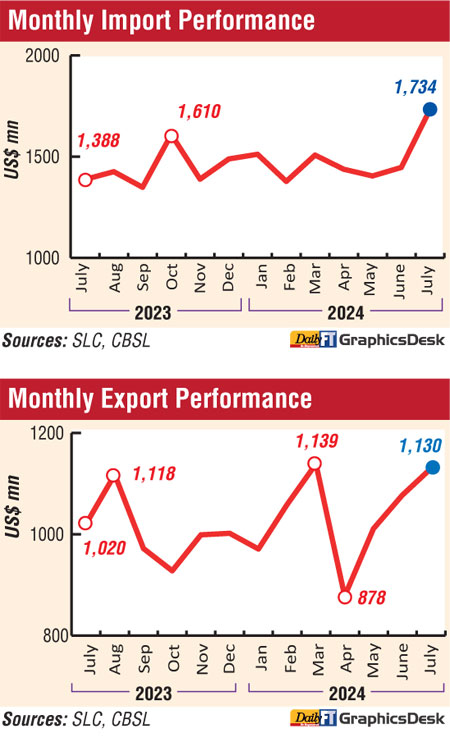Friday Dec 12, 2025
Friday Dec 12, 2025
Monday, 2 September 2024 02:03 - - {{hitsCtrl.values.hits}}
 Sri Lanka’s trade deficit widened by $ 237 million to $ 604 million in July from a year earlier, fuelled by a significant rise in import expenditure, which outpaced growth in export earnings.
Sri Lanka’s trade deficit widened by $ 237 million to $ 604 million in July from a year earlier, fuelled by a significant rise in import expenditure, which outpaced growth in export earnings.
The cumulative trade deficit for the first seven months of 2024 also saw an increase, reaching $ 3.14 billion compared to $ 2.65 billion during the same period in 2023.
Expenditure on merchandise imports rose by 25% year-on-year (YoY), to $ 1,734 million in July 2024. Expenditure increased across all major import categories, with the largest increase in intermediate goods and investment goods.
The import volume index increased by 29.1%, while the unit value index declined by 3.2%, implying that the increase in import expenditure in July 2024 compared to July 2023 was also driven by the volume effect.
Earnings from merchandise exports recorded an increase of 10.8% YoY to $ 1,130 million in July 2024. The increase was broad-based with the major contribution from industrial exports.
The export volume index improved by 15.7%, while the unit value index declined by 4.3%, implying that the increase in export earnings in July 2024 compared to July 2023 can be attributed to higher export volumes.
In terms of trade, i.e., the ratio of the price of exports to the price of imports deteriorated by 1.1% in July 2024 compared to July 2023, as the decline in the prices of exports surpassed the decline in the prices of imports.
Detailing imports, the Central Bank said expenditure on the importation of consumer goods increased by 21.2% YoY to $ 323.3 million in July 2024 compared to a year ago as a result of higher expenditure on both food and beverages which amounted to $ 177.7 million, and non-food consumer goods amounting to $ 145.6 million (primarily, clothing and accessories, home appliances, and telecommunication devices imports).
Meanwhile, expenditure on intermediate goods imports increased by 20.9% to $ 1.06 billion, primarily due to higher textiles and textile articles imports, compared to July 2023, with notable increases also seen in base metals and chemical products imports.
However, expenditure on fuel declined by 11.6% to $ 336.9 million in July 2024 due to lower crude oil imports.
Expenditure on investment goods recorded a broad-based increase of 44.9% to $ 343.9 million, driven primarily by higher imports of machinery and equipment ($ 222.5 million).
Detailing export performance, the Central Bank said the increase in exports of industrial goods by 9.5% to $ 860.9 million in July 2024 (YoY) was mainly contributed by petroleum products, which saw a 146.8% increase due to the boost in volumes of bunkering and aviation fuel exports, while exports of textiles and garments saw an increase of 3.7% to $ 444.6 million and transport equipment also registered a notable improvement of 191.7%.
Earnings from exports of agricultural goods improved by 14.8% to $ 264.9 million, driven by spices (mainly, pepper), tea (led by higher prices), and coconut-related products, despite a decline in minor agricultural exports. Earnings from mineral exports also increased by 36% in July 2024.
Total inflows to the services sector, excluding earnings from tourism, were estimated at $ 337 million in July 2024 compared to $ 311 million in July 2023.
Services inflows to computer and IT/BPO related services and the sea transport sector were the main contributors to the increase in inflows to the services sector, excluding earnings from tourism in July 2024.
Total services sector outflows were estimated at $ 290 million in July 2024, compared to $ 161 million in July 2023. Major contributors to the increase in outflows from the services sector in July 2024 were overseas travel, sea transport, and air transport.